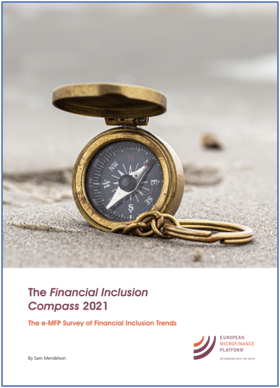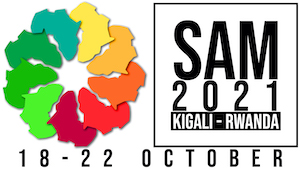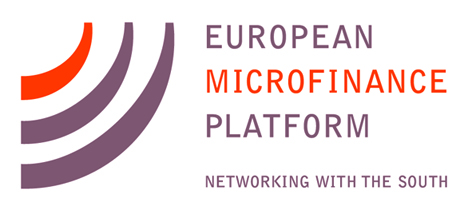 This paper reviews the impacts of multiple agricultural partial credit guarantee schemes (PCGSs), through which governments agree to absorb a portion of lenders’ losses on particular loans or loan portfolios. Governments often use PCGSs to de-risk financial institutions’ lending to small and medium-sized enterprises (SMEs), especially as a countercyclical tool in times of
This paper reviews the impacts of multiple agricultural partial credit guarantee schemes (PCGSs), through which governments agree to absorb a portion of lenders’ losses on particular loans or loan portfolios. Governments often use PCGSs to de-risk financial institutions’ lending to small and medium-sized enterprises (SMEs), especially as a countercyclical tool in times of
Search Results for: microfinance financial crisis
MICROFINANCE PAPER WRAP-UP: “Microfinance Clients Facing the COVID-19 Crisis: From Findings to Action for MFIs;” by Mathilde Bauwin, Thu Hien Dao; Published by ADA
This  paper explores the impact of the COVID-19 pandemic on clients of microfinance institutions (MFIs) in terms of: “Which client segments are most affected? How are they coping with the situation? What are they doing to
paper explores the impact of the COVID-19 pandemic on clients of microfinance institutions (MFIs) in terms of: “Which client segments are most affected? How are they coping with the situation? What are they doing to
MICROFINANCE EVENT: The SAM (Semaine Africaine de la Microfinance); October 18-22, 2021; Kigali, Rwanda
This  year’s SAM (Semaine Africaine de la Microfinance) includes five days of conference sessions, an investors’ fair, an “Innovators’ Village,” research presentations, training sessions and workshops under the theme “Resilience of the African Inclusive Finance Sector.” The two-day conference portion of SAM includes sessions on topics such as how the COVID-19 pandemic has affected efforts to meet the UN Sustainable Development Goals, financing agricultural value chains, risk management, serving youth, digital infrastructure and post-crisis reconstruction. The other days of SAM include workshops on topics such as social performance,
year’s SAM (Semaine Africaine de la Microfinance) includes five days of conference sessions, an investors’ fair, an “Innovators’ Village,” research presentations, training sessions and workshops under the theme “Resilience of the African Inclusive Finance Sector.” The two-day conference portion of SAM includes sessions on topics such as how the COVID-19 pandemic has affected efforts to meet the UN Sustainable Development Goals, financing agricultural value chains, risk management, serving youth, digital infrastructure and post-crisis reconstruction. The other days of SAM include workshops on topics such as social performance,
MICROFINANCE PAPER WRAP-UP: “Leadership as a Driver of Innovative Financial Services for Women;” by Jaclyn Berfond, Jennifer Iwueze; Published by WWB
This  paper offers an analysis of data collected from alumni of the Women’s World Banking Leadership & Diversity for Innovation Program (LDIP), which engages “senior executives and high-potential women leaders to enable them to successfully serve low-income women” customers of financial service providers (FSPs). The authors focus on “the strategic business initiatives of LDIP participants” and
paper offers an analysis of data collected from alumni of the Women’s World Banking Leadership & Diversity for Innovation Program (LDIP), which engages “senior executives and high-potential women leaders to enable them to successfully serve low-income women” customers of financial service providers (FSPs). The authors focus on “the strategic business initiatives of LDIP participants” and
SPECIAL REPORT: “Financial Inclusion Compass 2021” Reveals a Sector Grappling with the Consequences of COVID-19 – and Trying to Look Beyond It
In 2018, e-MFP launched the first Financial Inclusion Compass, a new annual publication series to collate sector opinions on emerging short-, medium- and long-term trends in the financial inclusion sector. e-MFP is delighted to now publish the English language version of the Financial Inclusion Compass 2021 – the fourth in the series.
2018, e-MFP launched the first Financial Inclusion Compass, a new annual publication series to collate sector opinions on emerging short-, medium- and long-term trends in the financial inclusion sector. e-MFP is delighted to now publish the English language version of the Financial Inclusion Compass 2021 – the fourth in the series.
The survey on which this paper is based was open in May 2021, with financial services providers (FSPs), investors, donors, researchers and support services providers evaluating and describing the importance of various current Trends, rating future New Areas of Focus, and providing open-comment qualitative input on the expected (and hoped-for) direction of financial inclusion progress.
The survey had two main sections: in Section 1, respondents rated from 1-10 the current importance of a list of 20 Trends and evaluated a list of 16 future New Areas of Focus to rank their highest five in terms of future significance. Optional comments on each were possible. Section 2 had three optional and open-ended questions, with a focus on the impact of the pandemic.
The Compass received 125 responses from 39 countries. A plurality of respondents were FSPs, followed by consultants/support services providers, infrastructure organisations, funders and researchers. On the main geographic focus of respondents’ work, a plurality selected Global, followed by Sub-Saharan Africa, Asia and Latin America.
Trends
Two new trends, introduced in response to the uniquely challenging context of the pandemic, took the top two spots
MICROFINANCE WRAP-UP: “Resilience: COVID-19 Crisis Through A Migration Lens;” Published by Global Knowledge Partnership on Migration and Development (KNOMAD)
This  brief provides an overview of recent trends in migration and remittances globally. Overall, remittances to low- and middle-income countries (LMICs) remained relatively stable through the onset of the COVID-19 pandemic, decreasing from USD 548 billion in 2019 to USD 540 billion in 2020. Many countries used “counter-cyclical fiscal policy” to stimulate their economies, which
brief provides an overview of recent trends in migration and remittances globally. Overall, remittances to low- and middle-income countries (LMICs) remained relatively stable through the onset of the COVID-19 pandemic, decreasing from USD 548 billion in 2019 to USD 540 billion in 2020. Many countries used “counter-cyclical fiscal policy” to stimulate their economies, which
SPECIAL REPORT: SAM 2021 to Take Place in Kigali, Rwanda, October 18-22; “One Is Not Born Resilient But Becomes Resilient: Fostering Inclusive Finance to Better Overcome Crisis!”
From  ADA: It’s official! The largest event in inclusive finance on the African continent, the long awaited African Microfinance Week (AMW 2021), will take place in Kigali, in the land of 1,000 hills and mountains: Rwanda. From October 18 to October 22, 2021, the SAM will address the theme of resilience, a concern that is all the more important in these particular times.
ADA: It’s official! The largest event in inclusive finance on the African continent, the long awaited African Microfinance Week (AMW 2021), will take place in Kigali, in the land of 1,000 hills and mountains: Rwanda. From October 18 to October 22, 2021, the SAM will address the theme of resilience, a concern that is all the more important in these particular times.
This notice is the first in a
MICROFINANCE PAPER WRAP-UP: “Weathering the Storm II: Tales of Survival from Microfinance Crises Past;” by Daniel Rozas; Published by Accion’s Center for Financial Inclusion, e-MFP
Mr Rozas evaluated 16 case studies of microfinance institutions’ (MFIs’) reactions to various crises that arose between 2004 and 2018 as a follow-up to the paper, “Weathering the Storm,” which was published in 2010 as a response to the global financial downturn that began in 2007. The new publication considers “the decade that followed the original paper,
MICROFINANCE PAPER WRAP-UP: “Evidence Review of Women’s Groups and COVID-19: Impacts, Challenges, and Policy Implications for Savings Groups in Africa;” by Eva Namisango et al
This brief offers evidence on how COVID-19 has affected women’s savings groups in sub-Saharan Africa – with a specific focus on Nigeria and Uganda – including how these groups have helped to “mitigate the pandemic’s negative consequences.” In a savings group, members pool their savings, lend out these funds and share the resulting profits. In addition to
MICROCAPITAL BRIEF: Pahal Financial Services Borrowing $3.5m from Grameen Crédit Agricole Foundation for Microfinance for Women in India
The Grameen Crédit Agricole (GCA) Foundation, whose head office is in Luxembourg, has agreed to lend EUR 3 million (USD 3.5 million) over three years to Pahal Financial Services, a microfinance institution based in Ahmedabad, India. Caroline Brandt, senior investment manager at GCA Foundation, stated that the partnership will
MICROFINANCE PAPER WRAP-UP: “Crisis Roadmap for Microfinance Institutions: COVID-19 and Beyond,” by Julie Abrams, Published by CGAP
The author structures this publication as an 11-step “roadmap” for microfinance institutions (MFIs) to respond to the COVID-19 pandemic and its economic impacts as well as to develop resilience going forward.
SPECIAL REPORT: Strong Motivation to Save, “Extreme Resilience During Times of Crisis” Despite Microfinance Institutions’ “Smothering” Loan Offers Pre-pandemic
During  the plenary titled “Creating an Environment for Effective and Inclusive Savings” on day two of European Microfinance Week, Stuart Rutherford of the Hrishipara Daily Diaries Project suggested thinking of savings as two separate services – collection and storage. While storage is primary for a person with regular paychecks deposited into a bank electronically, collection is critical for cash earners. This is why the service of a susu worker, who collects deposits frequently door-to-door and then returns “withdrawals” periodically, is so valuable that people are willing to pay fees for it.
the plenary titled “Creating an Environment for Effective and Inclusive Savings” on day two of European Microfinance Week, Stuart Rutherford of the Hrishipara Daily Diaries Project suggested thinking of savings as two separate services – collection and storage. While storage is primary for a person with regular paychecks deposited into a bank electronically, collection is critical for cash earners. This is why the service of a susu worker, who collects deposits frequently door-to-door and then returns “withdrawals” periodically, is so valuable that people are willing to pay fees for it.
Luis Treviño Garza of the Alliance for Financial Inclusion noted that savings is an “important factor for resilience, especially for vulnerable groups.” He added that “from the regulator’s perspective savings is really crucial… above credit.”
Mr Rutherford said that “all the diaries I’ve [collected in Bangladesh] show that poor people have a strong propensity to
SPECIAL REPORT: Lessons, Tools for the Pandemic from Prior Microfinance Crises
Deborah  Drake of Accion’s CFI opened a European Microfinance Week session on crises in microfinance by noting that the effect of COVID-19 on the financial inclusion industry “is a different crisis because it is global.” In past crises, which were centered on a single economy, microfinance investors had sufficient capacity to inject into stronger institutions to help them survive. The global nature of the current downturn, however, may exceed the capacity of investors to sustain “worthy” financial services providers (FSPs) in certain markets. “There is inevitable
Drake of Accion’s CFI opened a European Microfinance Week session on crises in microfinance by noting that the effect of COVID-19 on the financial inclusion industry “is a different crisis because it is global.” In past crises, which were centered on a single economy, microfinance investors had sufficient capacity to inject into stronger institutions to help them survive. The global nature of the current downturn, however, may exceed the capacity of investors to sustain “worthy” financial services providers (FSPs) in certain markets. “There is inevitable
MICROCAPITAL BRIEF: COFIDES Launches $145m Huruma Fund to Deliver Microfinance to 45k Farmers on 4 Continents
Compañia Española de Financiación del Desarrollo (COFIDES), a development finance institution controlled by the Spanish government, recently launched the Huruma Fund, an investment vehicle with commitments of EUR 120 million (USD 145 million) to assist rural farmers in Asia, sub-Saharan Africa, and Latin America and the Caribbean via a range of intermediaries. Seventy percent of Huruma’s portfolio will be deployed via
SPECIAL REPORT: Muktinath Bikas Bank of Nepal Wins $119k European Microfinance Award for Excellence in Savings
From  the European Microfinance Platform (e-MFP): Banks’ traditional activities include the collection of savings, the distribution of loans and the provision of means of payment. Credit products (also known as micro-credit solutions) were the first products to be developed in inclusive finance. Being more lucrative for the service provider, loans have long been the only type of product offered by banks. Yet, savings products also carry many advantages. For vulnerable, excluded and low-income populations, savings help secure a
the European Microfinance Platform (e-MFP): Banks’ traditional activities include the collection of savings, the distribution of loans and the provision of means of payment. Credit products (also known as micro-credit solutions) were the first products to be developed in inclusive finance. Being more lucrative for the service provider, loans have long been the only type of product offered by banks. Yet, savings products also carry many advantages. For vulnerable, excluded and low-income populations, savings help secure a
SPECIAL REPORT: Resilience Among Microfinance Institutions? “Region of Crisis” Relatively Stable; “Moratorium Veil” Yet to Lift
As  part of the opening day of European Microfinance Week, Mohammed Khaled of the World Bank Group’s International Finance Corporation stated that the effects of the COVID-19 pandemic on the microfinance sector in the Middle East and North Africa (MENA) so far have not been as bad as was feared earlier in 2020. Most of the large microfinance institutions (MFIs) in the region have maintained 30-day portfolio-at-risk (PAR) ratios below 4 percent. Mr Khaled said, “Among leading MFIs, PAR did not rise as high as expected. We thought [it might rise to] 10 percent to 20 percent, but many MFIs have kept things under control.” Part of the reason for this, he believes is that “this is
part of the opening day of European Microfinance Week, Mohammed Khaled of the World Bank Group’s International Finance Corporation stated that the effects of the COVID-19 pandemic on the microfinance sector in the Middle East and North Africa (MENA) so far have not been as bad as was feared earlier in 2020. Most of the large microfinance institutions (MFIs) in the region have maintained 30-day portfolio-at-risk (PAR) ratios below 4 percent. Mr Khaled said, “Among leading MFIs, PAR did not rise as high as expected. We thought [it might rise to] 10 percent to 20 percent, but many MFIs have kept things under control.” Part of the reason for this, he believes is that “this is
SPECIAL REPORT: Saving(s) Microfinance in a Pandemic – and Beyond
Back in the distant pre-pandemic memory, e-MFP launched the European Microfinance Award (EMA) 2020 on Encouraging Effective & Inclusive Savings. While clearly an important topic, with innovations across the sector that are ripe for exposure and commendation, little did we know just how relevant a topic it would turn out to be.
in the distant pre-pandemic memory, e-MFP launched the European Microfinance Award (EMA) 2020 on Encouraging Effective & Inclusive Savings. While clearly an important topic, with innovations across the sector that are ripe for exposure and commendation, little did we know just how relevant a topic it would turn out to be.
Many ema 525 wide.gif) months later, the sector has suffered – and continues to reel from – challenges on multiple fronts: to clients, financial services providers, investors, support providers and others, all trying to mitigate losses and preserve the important gains made over recent decades.
months later, the sector has suffered – and continues to reel from – challenges on multiple fronts: to clients, financial services providers, investors, support providers and others, all trying to mitigate losses and preserve the important gains made over recent decades.
Among the clearest lessons revealed by this difficult year is that
MICROFINANCE PAPER WRAP-UP: “Never Waste a Crisis: How Sub-Saharan African Insurers Are Being Affected by, and Are Responding to, COVID-19;” by Lucia Schlemmer, Kate Rinehart-Smit, Jeremy Gray
This paper analyzes the effect that the COVID-19 pandemic has had on the insurance market in sub-Saharan Africa and the effectiveness of the responses of insurers, brokers and regulators. The authors conducted 32 interviews with representatives of insurers, insurance technology (insurtech) firms, reinsurers, and insurance and broker associations across 18 markets in the region to assess: (1) the impact that the pandemic has had on insurers’ daily internal operations; (2) the impacts on new product development and how the insured move through current processes; (3) the impact on insurers’ and customers’ finances; and
